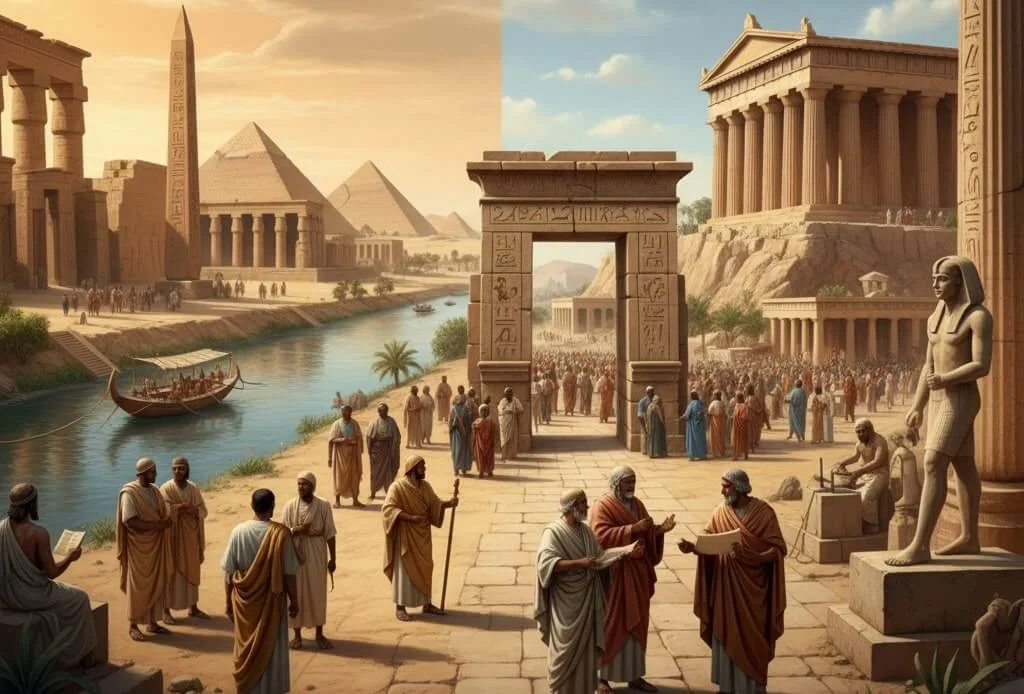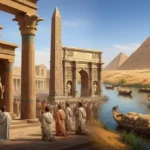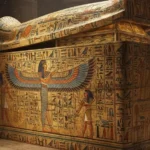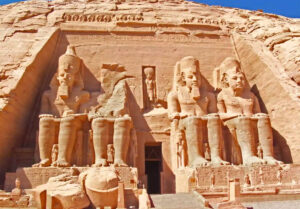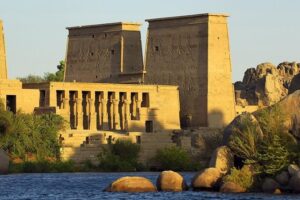Egyptian Influence on Greek Civilization
Discover the Egyptian influence on Greek civilization, from its monumental architecture and early sculpture to its philosophy, and religion. Ancient Greece is often called the cradle of Western civilization. It developed many of its ideas from older cultures. Ancient Egypt was a huge source of inspiration and knowledge. The exchange wasn’t one-sided. This cultural give-and-take deeply shaped early Greek civilization. It influenced their art, architecture, religion, and philosophy.
Early Contact and Trade Routes
Interaction between Greece and Egypt dates back to the Bronze Age, long before the classical period. Mycenaean Greeks traded extensively with Egypt, importing goods like papyrus, linen, and exotic materials. These early connections laid the groundwork for later, more significant cultural exchanges. By the Archaic period (c. 800-500 BCE), Greek merchants established trading posts, most notably Naucratis in the Nile Delta. This city became a vital hub, fostering direct and sustained contact between Greeks and Egyptians. Through these commercial arteries, ideas, technologies, and artistic styles flowed freely.
Egyptian influence on Greek civilization: The Temple and Column
Greek architecture, especially its monumental temple building, shows clear echoes of Egyptian precedents. Early Greek temples, with their massive stone construction and columned facades, share striking similarities with Egyptian temple complexes. While the Greeks developed their unique orders (Doric, Ionic, Corinthian), the very concept of using rows of columns to support a roof and define sacred space likely stemmed from observing Egyptian temples.
Consider the sheer scale and durability of Egyptian architecture. Greek architects would have been inspired by structures like the Temple of Karnak or the mortuary temples on the west bank of the Nile. They adopted techniques for quarrying, transporting, and precisely fitting large stone blocks. The transition from timber to stone construction in Greece was a significant leap, undoubtedly influenced by Egyptian expertise in monumental masonry.
Egyptian influence on Greek civilization: Sculpture and Statuary
Early Greek sculpture, particularly the Archaic kouros and kore statues, bears an unmistakable resemblance to Egyptian statuary. These rigid, front-facing figures, often with one foot slightly advanced and arms held stiffly at their sides, mirror the canonical pose of Egyptian statues. Greek artists adopted the Egyptian grid system for proportioning the human body, ensuring consistency in their monumental works.
While Greek sculpture eventually evolved into more naturalistic and dynamic forms, the initial influence provided a crucial starting point. Egyptian artists had centuries of experience in depicting the human form in stone, and Greek sculptors learned valuable techniques and aesthetic principles from them. This foundational learning allowed Greek art to flourish into its own distinct style.
Religious Syncretism and Mythological Parallels
Egyptian religious beliefs seeped into Greek thought, often merging with existing Greek deities and myths. The cult of Isis, with its promise of an afterlife and a strong female deity, later became immensely popular in the Hellenistic and Roman worlds, but its roots in Greek consciousness began much earlier. Greek writers like Herodotus noted the similarities between some Egyptian gods and their own. For example, they often equated the Egyptian god Thoth with Hermes, and Amun with Zeus.
Philosophers like Pythagoras and Plato reputedly traveled to Egypt, absorbing esoteric knowledge and religious concepts. Plato’s writings, particularly his theories about the soul and the afterlife, show subtle but discernible parallels with Egyptian ideas. The Eleusinian Mysteries, a prominent Greek mystery cult, might have also drawn inspiration from Egyptian rituals concerning death and resurrection, particularly those associated with Osiris.
Writing and the Legacy of Papyrus
The Greeks developed their own alphabet from Phoenician sources. However, Egypt profoundly influenced the technology of writing and its materials. The ancient world’s premier writing material was papyrus, which came from Nile reeds. It was much more durable and convenient than clay tablets. Greek scribes and scholars adopted papyrus. This helped them widely share literature, philosophy, and records.
Egypt’s long tradition of written scholarship influenced the Greeks’ very act of writing. Creating extensive libraries and academic texts was also part of this influence. The efficient use of papyrus allowed Greeks to record and preserve their intellectual achievements for posterity.
Philosophical and Scientific Exchange
Greek thinkers often looked to Egypt as a source of ancient wisdom. Egyptian advancements in mathematics, astronomy, and medicine captivated Greek scholars. Early Greek philosophers like Thales of Miletus, often considered the first philosopher, is said to have studied in Egypt, learning geometry. The Egyptians’ practical knowledge in land surveying (geometry) for rebuilding fields after Nile floods provided a fertile ground for Greek theoretical advancements.
In medicine, Egyptian knowledge of anatomy and pharmacology, evidenced in ancient medical papyri like the Ebers Papyrus, influenced early Greek medical practices. Figures like Hippocrates, the “father of medicine,” built upon centuries of observed medical practices and treatments, some of which had Egyptian origins.
In conclusion, the relationship between Egypt and Greece was a dynamic exchange that significantly shaped the nascent Greek civilization. From the monumental scale of their architecture and the rigid beauty of their early sculpture to the complexities of their religious beliefs and the foundations of their scientific inquiry, Egyptian influence provided a rich substratum upon which Greek genius could build. This cross-cultural dialogue demonstrates that even the most original civilizations are products of diverse global interactions.


